Prague Calvary
The official title is the Statuary of the Holy Crucifix and Calvary. You may think this is just another statue on Charles Bridge. Actually you will find out that it was the original figure on the bridge, the most historic and the most religiously divisive. We’re talking legends and blasphemy. There are two parts to the story. Firstly the reason for the Calvary and secondly the reason for the Hebrew text.
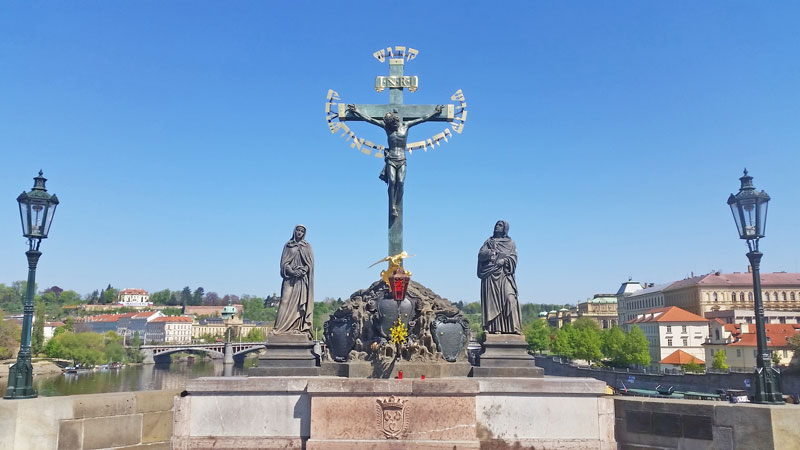
Consecration of Charles Bridge
Most historic guides will have 1357 as the year Charles Bridge was built. Historically that’s correct if you consider that was when it was opened for use, not finished. Most guides miss the fact that it was not consecrated until 1361 when the original Prague Calvary cross made of wood with a wooden corpus (crucified body of Christ) was installed and Christians would “tip the hat” to the cross as they passed. This remained until @1419 when it was destroyed during the Hussite Wars. We know that in 1619 the Prague Calvary had been replaced but was still just a wooden cross. During the Thirty Years War the Calvinist Queen Elizabeth Stuart wanted it removed as the sight of having to pass Christ on the cross offended her. It was never taken down because in November 1620 the Catholics took control of the city again.
1657
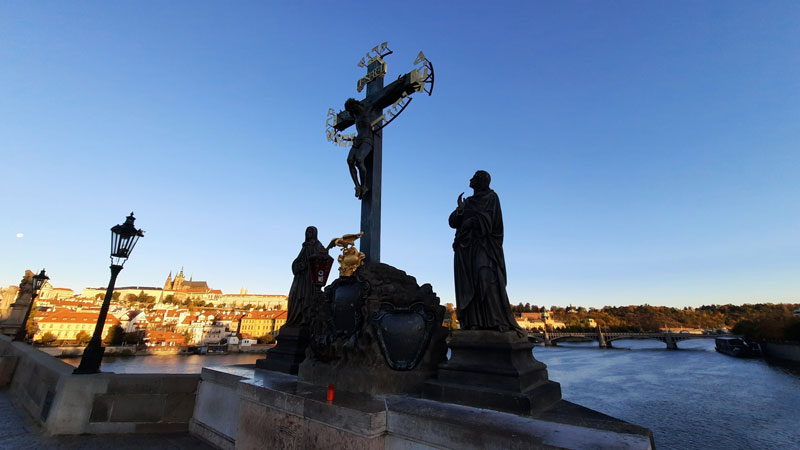
On the 300th anniversary of the opening of Charles Bridge the Prague Calvary got a significant upgrade because although the cross remained wooden, the corpus was now made from gilded bronze (it had actually been made in Germany by a bell maker in 1629). The original lead statues of the Virgin Mary and John the Baptists were added in 1666. It was the only decoration on Charles Bridge until 1683 when the Jan Nepomuk Statue was erected.
1693
This is the core of the legend surrounding the Prague Calvary. An event happened and there are two versions of the story so I’ll explain both.
Version 1: Guidebooks will commonly refer to a man called Elias Backoffen who was a Prague Jew who “debased” the cross. This has been described as saying something bad to Christians praying at the cross, or spitting on the cross, or generally being disdainful.
Version 2: In Prague Jewish History the name Elias Backoffen comes up again but this time he is identified as a Jewish leader who has a dispute with a Jewish merchant called Aaron Lichtenstadt and it was this man who falsely accused Elias Backoffen of Blasphemy.
A year after the event Elias Backoffen had avoided prison but, depending on what you read he either had to pay a huge fine of 1000 gold Florins or his punishment was to raise 1000 gold Florins to pay for the next stage of this story..
1696
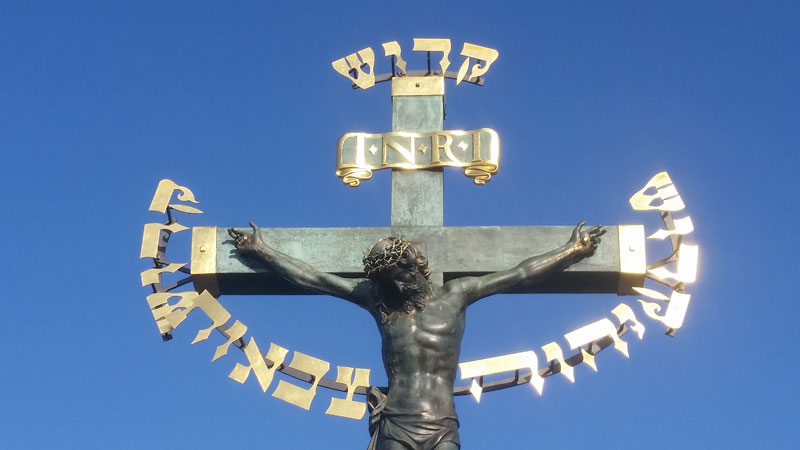
Two years after the fine was paid, somebody, possibly Jesuit, decided to make an example of the case and from September 1696 people passing the Prague Calvary saw Hebrew Text on the cross and it read Holy, Holy, Holy, the Lord God of Hosts (as you stand in front of the statue you’ll see the holies are at the top and the sides with “Lord God of Hosts” in between). You’ll read in many guides that the fine paid for the changes but as they were two years apart the most you could say would be that the cost of the work was equivalent to the fine that Elias Backoffen paid.
1707
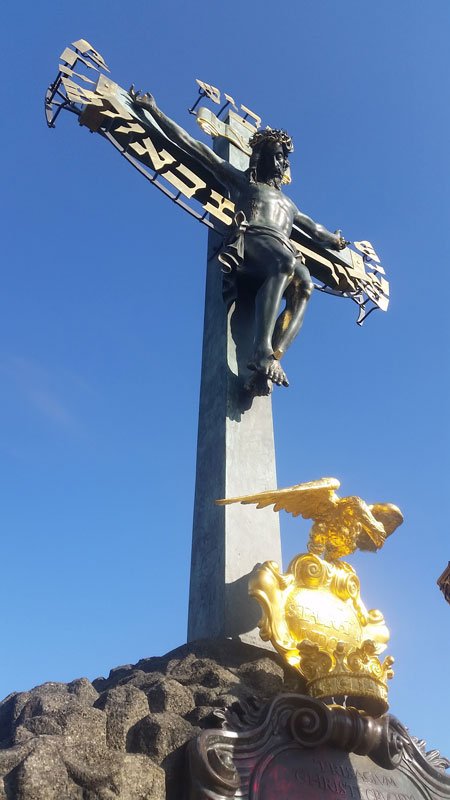
1707 saw two significant changes to the Prague Calvary. First, the wooden cross was replaced by a bronze version. Second, it acquired the stone base in the shape of the Golgotha hill where Christ was crucified.
1861
The old lead statues of the Virgin Mary and John the Baptist were replaced by sandstone versions by a guy called Emanuel Max and since then it has basically been the same except for in WW2 when Nazis removed the gold leaf from the Hebrew letters.
What’s the Big Deal About the Prague Calvary
Basically it’s about the Holy Trinity i.e. the Father, the Son and the Holy Spirit. Not to get into the whole religious question but both Jewish faith and Christian faith use the Sanctus hymn but it’s origin is Jewish. The Anglican version is:
Holy, holy, holy, Lord God of hosts,
heaven and earth are full of thy glory.
Glory be to thee, O Lord most high.
Blessed is he that cometh in the name of the Lord.
Hosanna in the highest.
Again, wishing to avoid the big religion thing but if you consider that Jesus Christ was Jewish then he was crucified on the symbol of Christian faith i.e. the cross. So the next time you visit a synagogue you’ll find the Christian cross is absent largely because Jewish people view it as a sign of oppression.
Clarification
What had begun as a trip to Prague in 1971 for a Rabbinical student ended in the year 2000 with a request from the now Rabbi Ronald Brown to the Mayor of Prague at the time (Jan Kasl) identifying what he believed to be an insult to Jewish people and requesting that the text be removed. The answer was NO! but there could be an arrangement to help visitors understand why the text is there and so after much back and forth the text was agreed. So now if you look at the base of the statue at ground level, on the right are three plaques in Hebrew, Czech and English.
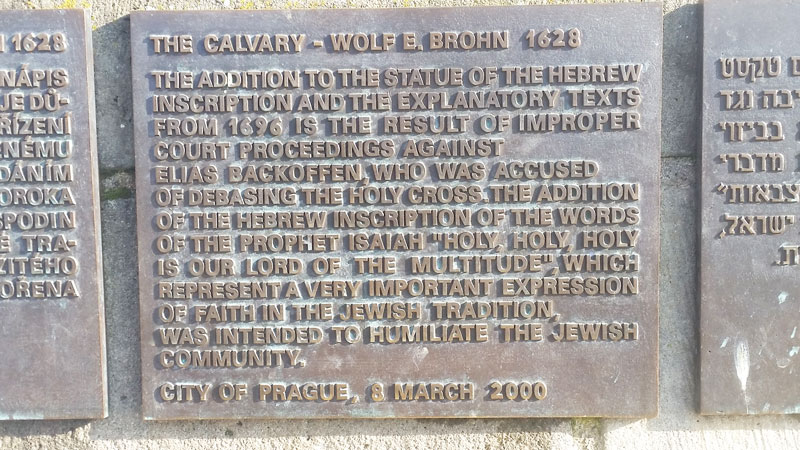
If you can’t see it properly it reads: The addition to the statue of the Hebrew inscription and the explanatory texts from 1696 is the result of improper court proceedings against Elias Backoffen, who was accused of debasing the Holy Cross. The addition of the Hebrew inscription of the words of the prophet Isiah “Holy, Holy, Holy is our lord of the multitude” which represent a very important expression of faith in the Jewish tradition, was intended to humiliate the Jewish community
The 3 plaques were unveiled on March 8th 2000 with the date chosen as a worldwide day for recognising Christian conciliation projects under Pope Jean-Paul II.
The Deliberate Mistake?
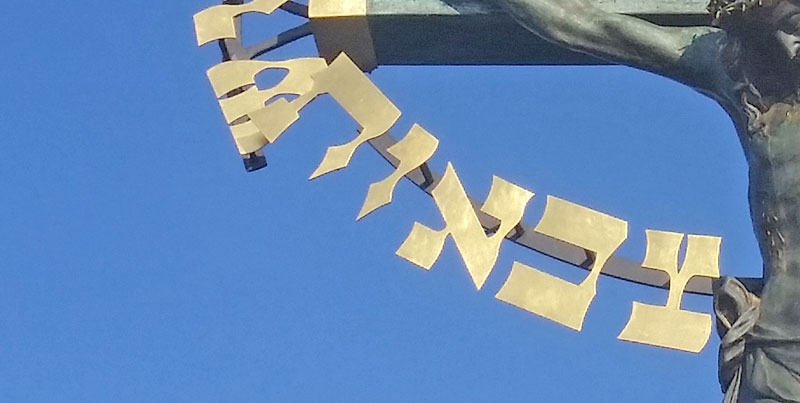
It’s such a small detail but in the “Lord God of Hosts” section of the Hebrew text on the cross there is one character which is upside-down. I’ve never been able to pin down exactly when this may have happened (has to be post WW2) or any significance so if anybody knows, feel free to contact me.
Something Related or a Few Minutes Away
Attraction – The Iconic Charles Bridge
Attraction – Jan Nepomuk Statue
Legends – The Water Wheel and the Demon
Activity – Charles Bridge Portrait Artists
